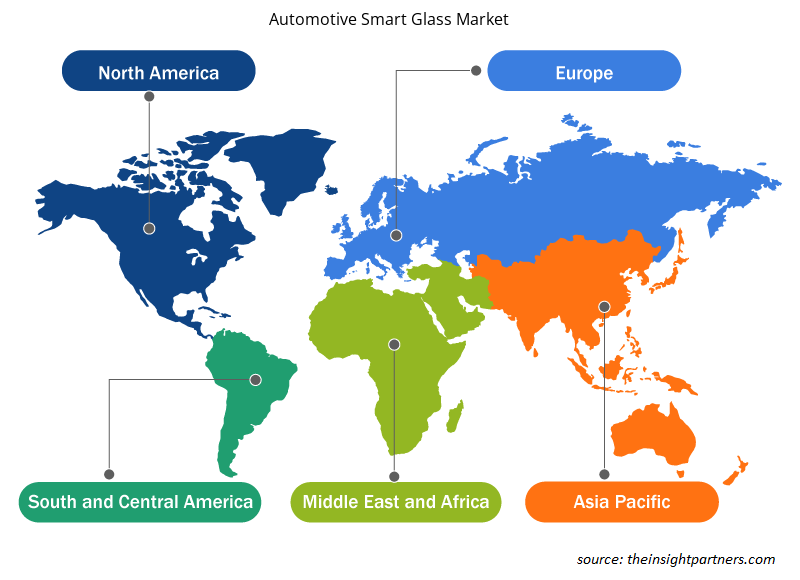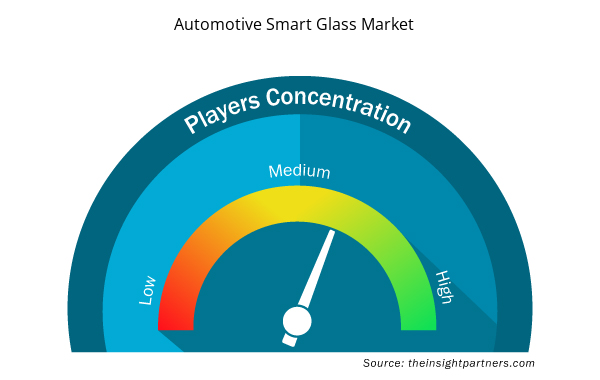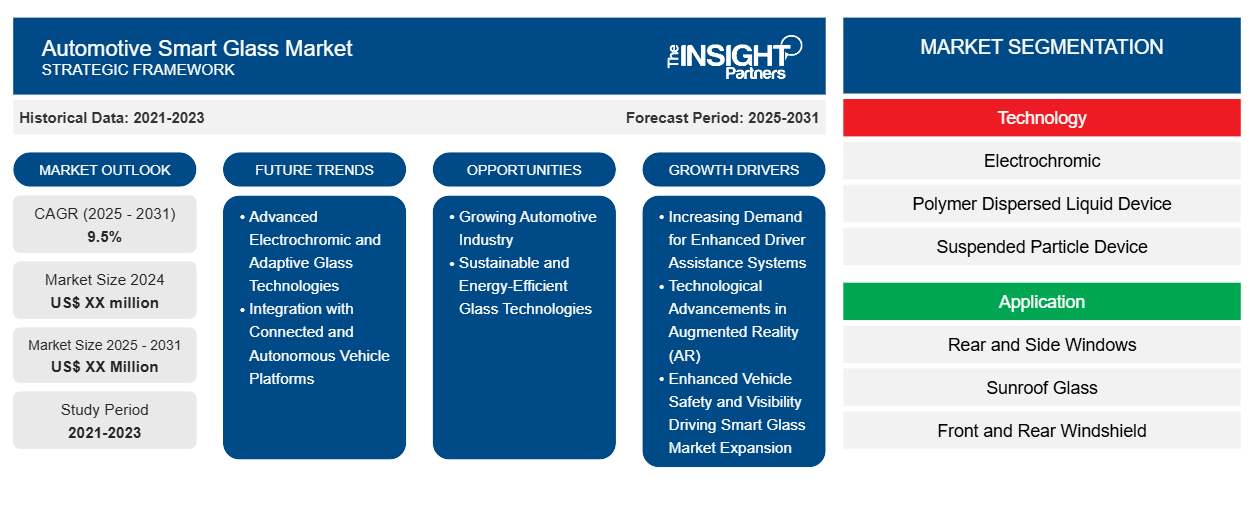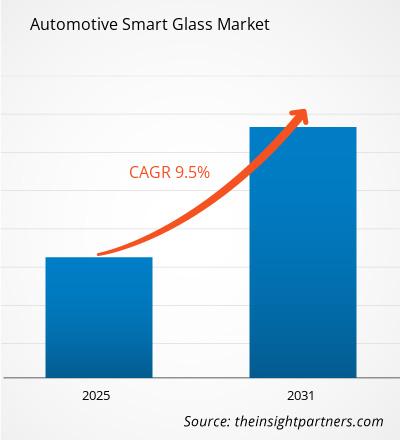Si prevede che il mercato dei vetri intelligenti per autoveicoli registrerà un CAGR del 9,5% dal 2023 al 2031, con una dimensione di mercato in espansione da XX milioni di dollari nel 2023 a XX milioni di dollari entro il 2031.
Il rapporto è segmentato per tecnologia (elettrocromica, dispositivo liquido disperso in polimeri (PDLC) e dispositivo a particelle sospese (SPD)), applicazione (finestrini posteriori e laterali, vetro del tettuccio apribile e parabrezza anteriore e posteriore), tipo di veicolo (autovetture e veicoli commerciali). L'analisi globale è ulteriormente suddivisa a livello regionale e nei principali paesi. Il rapporto offre il valore in USD per l'analisi e i segmenti di cui sopra.
Scopo del rapporto
Il report Automotive Smart Glass Market di The Insight Partners mira a descrivere il panorama attuale e la crescita futura, i principali fattori trainanti, le sfide e le opportunità. Ciò fornirà spunti a vari stakeholder aziendali, come:
- Fornitori/produttori di tecnologia: per comprendere le dinamiche di mercato in evoluzione e conoscere le potenziali opportunità di crescita, consentendo loro di prendere decisioni strategiche informate.
- Investitori: condurre un'analisi completa delle tendenze in merito al tasso di crescita del mercato, alle proiezioni finanziarie del mercato e alle opportunità esistenti lungo la catena del valore.
- Enti di regolamentazione: regolamentano le politiche e le attività di controllo sul mercato allo scopo di ridurre al minimo gli abusi, preservare la fiducia degli investitori e sostenere l'integrità e la stabilità del mercato.
Segmentazione del mercato del vetro intelligente per autoveicoli
Tecnologia
- Elettrocromico
- Dispositivo liquido disperso in polimero
- Dispositivo a particelle sospese
Applicazione
- Finestrini posteriori e laterali
- Vetro del tettuccio apribile
- Parabrezza anteriore e posteriore
Tipo di veicolo
- Autovetture passeggeri
- Veicoli commerciali
Geografia
- America del Nord
- Europa
- Asia-Pacifico
- America del Sud e Centro
- Medio Oriente e Africa
Geografia
- America del Nord
- Europa
- Asia-Pacifico
- America del Sud e Centro
- Medio Oriente e Africa
Personalizza questo report in base alle tue esigenze
Riceverai la personalizzazione gratuita di qualsiasi report, comprese parti di questo report, o analisi a livello nazionale, pacchetto dati Excel, oltre a usufruire di grandi offerte e sconti per start-up e università
- Scopri le principali tendenze di mercato in questo rapporto.Questo campione GRATUITO includerà analisi di dati che spaziano dalle tendenze di mercato alle stime e alle previsioni.
Driver di crescita del mercato del vetro intelligente per l'automotive
- Domanda crescente di sistemi avanzati di assistenza alla guida: ci sarà una domanda crescente di sistemi avanzati di assistenza alla guida poiché c'è un'attenzione verso ADAS nel settore automobilistico, che rende la guida più sicura e piacevole. Gli occhiali intelligenti possono rendere le informazioni disponibili al conducente in tempo reale come richieste di navigazione, limiti di velocità e avvisi di pericolo; pertanto, gli occhiali intelligenti miglioreranno la consapevolezza della situazione garantendo al contempo la sicurezza nel veicolo. Questa innovazione nell'utilizzo degli occhiali intelligenti nei veicoli supporta gli sforzi del settore verso ambienti di guida più sicuri e più connessi.
- Progressi tecnologici nella realtà aumentata (RA): la tecnologia della realtà aumentata sta avanzando molto rapidamente e sta guidando il mercato degli occhiali intelligenti per auto. Più la RA diventa avanzata, più offre nuove possibilità per una presentazione user-friendly di informazioni critiche. I produttori di automobili sono ora interessati a combinare l'uso di occhiali intelligenti con informazioni digitali sovrapposte al mondo reale per migliorare l'esperienza di guida e fornire soluzioni innovative per la navigazione e la diagnostica del veicolo. Lo sviluppo del mercato degli occhiali intelligenti è significativamente influenzato dalla convergenza delle tecnologie dell'esperienza utente e dell'elettronica del veicolo. I clienti sono alla ricerca di interfacce per auto più sofisticate e interattive che funzionino bene con i sistemi digitali. Per trasformare i vetri delle auto convenzionali in piattaforme di comunicazione e informazione avanzate, le tecnologie degli occhiali intelligenti si stanno sviluppando per includere display di realtà aumentata, sistemi di informazione heads-up e superfici interattive.
- Maggiore sicurezza e visibilità dei veicoli che guidano l'espansione del mercato dei vetri intelligenti: la crescente domanda di tecnologie di sicurezza avanzate sta spingendo la crescita del mercato dei vetri intelligenti per l'automotive. Le tecnologie dei vetri intelligenti offrono una migliore visibilità, una trasmissione della luce adattiva e una maggiore protezione del conducente contro l'abbagliamento e le condizioni di illuminazione estreme. I produttori stanno sviluppando soluzioni di vetro intelligenti che regolano automaticamente la trasparenza, riducono l'affaticamento degli occhi e forniscono una chiarezza visiva superiore in diverse condizioni ambientali, supportando i requisiti generali di sicurezza del veicolo e comfort del conducente.
Tendenze future del mercato del vetro intelligente per l'automotive
- Tecnologie avanzate di vetro elettrocromico e adattivo: il mercato del vetro intelligente per autoveicoli sta vivendo una tendenza trasformativa verso tecnologie elettrocromiche e adattive. Sistemi di vetro sofisticati in grado di regolare dinamicamente la trasparenza, bloccare le radiazioni nocive e fornire una gestione intelligente della luce stanno diventando sempre più diffusi. Queste tecnologie sfruttano materiali avanzati e sistemi di controllo elettronico per creare soluzioni di vetro reattive ed efficienti dal punto di vista energetico che migliorano le prestazioni del veicolo e il comfort dell'utente.
- Integrazione con piattaforme di veicoli connessi e autonomi: le tecnologie di vetro intelligenti vengono sempre più integrate con piattaforme di veicoli connessi e autonomi, creando sistemi di interazione utente più completi. Le soluzioni di vetro avanzate stanno incorporando tecnologie di sensori, display di realtà aumentata e interfacce interattive che supportano funzionalità di navigazione, comunicazione e gestione del veicolo. Questa tendenza consente soluzioni di vetro per autoveicoli più sofisticate e intelligenti che vanno oltre i tradizionali requisiti di visibilità e protezione.
Opportunità di mercato del vetro intelligente per l'automotive
- Crescita del settore automobilistico: i mercati automobilistici in via di sviluppo presentano opportunità significative per i produttori di smart glass per introdurre soluzioni innovative e specifiche per regione. La crescente sofisticatezza tecnologica, l'aumento dell'adozione di veicoli e l'evoluzione delle preferenze dei consumatori creano nuovi segmenti di mercato. I fornitori possono sviluppare tecnologie di smart glass su misura che affrontino sfide regionali uniche, come diverse condizioni climatiche, requisiti specifici degli utenti e infrastrutture tecnologiche localizzate.
- Tecnologie del vetro sostenibili ed efficienti dal punto di vista energetico: la crescente attenzione dell'industria automobilistica alla sostenibilità crea opportunità per sviluppare soluzioni di vetro intelligenti ecocompatibili. I produttori possono concentrarsi sulla creazione di tecnologie del vetro avanzate che supportano l'efficienza energetica, riducono il peso del veicolo e minimizzano l'impatto ambientale. Gli approcci innovativi potrebbero includere materiali autocoloranti, superfici in vetro che raccolgono energia e tecnologie avanzate di gestione termica che contribuiscono agli obiettivi generali di sostenibilità del veicolo.
Approfondimenti regionali sul mercato del vetro intelligente per l'automotive
Le tendenze regionali e i fattori che influenzano il mercato del vetro intelligente per l'automotive durante il periodo di previsione sono stati ampiamente spiegati dagli analisti di Insight Partners. Questa sezione discute anche i segmenti e la geografia del mercato del vetro intelligente per l'automotive in Nord America, Europa, Asia Pacifico, Medio Oriente e Africa e Sud e Centro America.

- Ottieni i dati regionali specifici per il mercato del vetro intelligente per autoveicoli
Ambito del rapporto sul mercato del vetro intelligente per autoveicoli
| Attributo del report | Dettagli |
|---|---|
| Dimensioni del mercato nel 2023 | XX milioni di dollari USA |
| Dimensioni del mercato entro il 2031 | XX milioni di dollari USA |
| CAGR globale (2023-2031) | 9,5% |
| Dati storici | 2021-2022 |
| Periodo di previsione | 2024-2031 |
| Segmenti coperti | Per tecnologia
|
| Regioni e Paesi coperti | America del Nord
|
| Leader di mercato e profili aziendali chiave |
|
Densità dei player del mercato del vetro intelligente per l'automotive: comprendere il suo impatto sulle dinamiche aziendali
Il mercato del vetro intelligente per l'automotive sta crescendo rapidamente, spinto dalla crescente domanda degli utenti finali dovuta a fattori quali l'evoluzione delle preferenze dei consumatori, i progressi tecnologici e una maggiore consapevolezza dei vantaggi del prodotto. Con l'aumento della domanda, le aziende stanno ampliando le loro offerte, innovando per soddisfare le esigenze dei consumatori e capitalizzando sulle tendenze emergenti, il che alimenta ulteriormente la crescita del mercato.
La densità degli operatori di mercato si riferisce alla distribuzione di aziende o società che operano in un particolare mercato o settore. Indica quanti concorrenti (operatori di mercato) sono presenti in un dato spazio di mercato in relazione alle sue dimensioni o al valore di mercato totale.
Le principali aziende che operano nel mercato dei vetri intelligenti per l'automotive sono:
- AGC Inc
- Corning Incorporata
- Gentex Corp.
- Società chimica Hitachi
- Pleotint, LLC
Disclaimer : le aziende elencate sopra non sono classificate secondo un ordine particolare.

- Ottieni una panoramica dei principali attori del mercato dei vetri intelligenti per autoveicoli
Punti di forza chiave
- Copertura completa: il rapporto esamina in modo completo i prodotti, i servizi, le tipologie e gli utenti finali del mercato dei vetri intelligenti per autoveicoli, offrendo una panoramica olistica.
- Analisi degli esperti: il rapporto è compilato sulla base della conoscenza approfondita di esperti e analisti del settore.
- Informazioni aggiornate: il rapporto garantisce la pertinenza aziendale grazie alla copertura di informazioni recenti e tendenze nei dati.
- Opzioni di personalizzazione: questo report può essere personalizzato per soddisfare le esigenze specifiche del cliente e adattarsi in modo appropriato alle strategie aziendali.
Il rapporto di ricerca sul mercato degli Smart Glass per l'automotive può quindi aiutare a guidare il percorso di decodifica e comprensione dello scenario del settore e delle prospettive di crescita. Sebbene possano esserci alcune preoccupazioni valide, i vantaggi complessivi di questo rapporto tendono a superare gli svantaggi.
- Analisi storica (2 anni), anno base, previsione (7 anni) con CAGR
- Analisi PEST e SWOT
- Valore/volume delle dimensioni del mercato - Globale, regionale, nazionale
- Industria e panorama competitivo
- Set di dati Excel


- Advanced Planning and Scheduling Software Market
- Medical Enzyme Technology Market
- Smart Water Metering Market
- Toothpaste Market
- Frozen Potato Market
- Space Situational Awareness (SSA) Market
- Quantitative Structure-Activity Relationship (QSAR) Market
- Tortilla Market
- Europe Surety Market
- Mobile Phone Insurance Market

Report Coverage
Revenue forecast, Company Analysis, Industry landscape, Growth factors, and Trends

Segment Covered
This text is related
to segments covered.

Regional Scope
North America, Europe, Asia Pacific, Middle East & Africa, South & Central America

Country Scope
This text is related
to country scope.
Domande frequenti
Some of the customization options available based on the request are an additional 3-5 company profiles and country-specific analysis of 3-5 countries of your choice. Customizations are to be requested/discussed before making final order confirmation, as our team would review the same and check the feasibility.
The leading players operating in the Automotive Smart Glass Market include AGC Inc, Corning Incorporated, Gentex Corp, Hitachi Chemicals Co Ltd, Pleotint LLC, PPG Industries, RavenBrick LLC, Research Frontiers Inc, and Saint Gobain
The Automotive Smart Glass Market is estimated to witness a CAGR of 9.5% from 2023 to 2031
The smart glasses on user-centric design is the key future trend of the Automotive Smart Glass Market
The major factors driving the Automotive Smart Glass Market are:Increasing Demand for Enhanced Driver Assistance Systems#Technological Advancements in Augmented Reality (AR)
The report can be delivered in PDF/PPT format; we can also share excel dataset based on the request.
Trends and growth analysis reports related to Automotive and Transportation : READ MORE..
1. AGC Inc2. Corning Incorporated3. Gentex Corp.4. Hitachi Chemicals Co. Ltd.5. Pleotint, LLC6. PPG Industries7. RavenBrick LLC8. Research Frontiers, Inc.9. Saint-Gobain10. View, Inc
The Insight Partners performs research in 4 major stages: Data Collection & Secondary Research, Primary Research, Data Analysis and Data Triangulation & Final Review.
- Data Collection and Secondary Research:
As a market research and consulting firm operating from a decade, we have published and advised several client across the globe. First step for any study will start with an assessment of currently available data and insights from existing reports. Further, historical and current market information is collected from Investor Presentations, Annual Reports, SEC Filings, etc., and other information related to company’s performance and market positioning are gathered from Paid Databases (Factiva, Hoovers, and Reuters) and various other publications available in public domain.
Several associations trade associates, technical forums, institutes, societies and organization are accessed to gain technical as well as market related insights through their publications such as research papers, blogs and press releases related to the studies are referred to get cues about the market. Further, white papers, journals, magazines, and other news articles published in last 3 years are scrutinized and analyzed to understand the current market trends.
- Primary Research:
The primarily interview analysis comprise of data obtained from industry participants interview and answers to survey questions gathered by in-house primary team.
For primary research, interviews are conducted with industry experts/CEOs/Marketing Managers/VPs/Subject Matter Experts from both demand and supply side to get a 360-degree view of the market. The primary team conducts several interviews based on the complexity of the markets to understand the various market trends and dynamics which makes research more credible and precise.
A typical research interview fulfils the following functions:
- Provides first-hand information on the market size, market trends, growth trends, competitive landscape, and outlook
- Validates and strengthens in-house secondary research findings
- Develops the analysis team’s expertise and market understanding
Primary research involves email interactions and telephone interviews for each market, category, segment, and sub-segment across geographies. The participants who typically take part in such a process include, but are not limited to:
- Industry participants: VPs, business development managers, market intelligence managers and national sales managers
- Outside experts: Valuation experts, research analysts and key opinion leaders specializing in the electronics and semiconductor industry.
Below is the breakup of our primary respondents by company, designation, and region:

Once we receive the confirmation from primary research sources or primary respondents, we finalize the base year market estimation and forecast the data as per the macroeconomic and microeconomic factors assessed during data collection.
- Data Analysis:
Once data is validated through both secondary as well as primary respondents, we finalize the market estimations by hypothesis formulation and factor analysis at regional and country level.
- Macro-Economic Factor Analysis:
We analyse macroeconomic indicators such the gross domestic product (GDP), increase in the demand for goods and services across industries, technological advancement, regional economic growth, governmental policies, the influence of COVID-19, PEST analysis, and other aspects. This analysis aids in setting benchmarks for various nations/regions and approximating market splits. Additionally, the general trend of the aforementioned components aid in determining the market's development possibilities.
- Country Level Data:
Various factors that are especially aligned to the country are taken into account to determine the market size for a certain area and country, including the presence of vendors, such as headquarters and offices, the country's GDP, demand patterns, and industry growth. To comprehend the market dynamics for the nation, a number of growth variables, inhibitors, application areas, and current market trends are researched. The aforementioned elements aid in determining the country's overall market's growth potential.
- Company Profile:
The “Table of Contents” is formulated by listing and analyzing more than 25 - 30 companies operating in the market ecosystem across geographies. However, we profile only 10 companies as a standard practice in our syndicate reports. These 10 companies comprise leading, emerging, and regional players. Nonetheless, our analysis is not restricted to the 10 listed companies, we also analyze other companies present in the market to develop a holistic view and understand the prevailing trends. The “Company Profiles” section in the report covers key facts, business description, products & services, financial information, SWOT analysis, and key developments. The financial information presented is extracted from the annual reports and official documents of the publicly listed companies. Upon collecting the information for the sections of respective companies, we verify them via various primary sources and then compile the data in respective company profiles. The company level information helps us in deriving the base number as well as in forecasting the market size.
- Developing Base Number:
Aggregation of sales statistics (2020-2022) and macro-economic factor, and other secondary and primary research insights are utilized to arrive at base number and related market shares for 2022. The data gaps are identified in this step and relevant market data is analyzed, collected from paid primary interviews or databases. On finalizing the base year market size, forecasts are developed on the basis of macro-economic, industry and market growth factors and company level analysis.
- Data Triangulation and Final Review:
The market findings and base year market size calculations are validated from supply as well as demand side. Demand side validations are based on macro-economic factor analysis and benchmarks for respective regions and countries. In case of supply side validations, revenues of major companies are estimated (in case not available) based on industry benchmark, approximate number of employees, product portfolio, and primary interviews revenues are gathered. Further revenue from target product/service segment is assessed to avoid overshooting of market statistics. In case of heavy deviations between supply and demand side values, all thes steps are repeated to achieve synchronization.
We follow an iterative model, wherein we share our research findings with Subject Matter Experts (SME’s) and Key Opinion Leaders (KOLs) until consensus view of the market is not formulated – this model negates any drastic deviation in the opinions of experts. Only validated and universally acceptable research findings are quoted in our reports.
We have important check points that we use to validate our research findings – which we call – data triangulation, where we validate the information, we generate from secondary sources with primary interviews and then we re-validate with our internal data bases and Subject matter experts. This comprehensive model enables us to deliver high quality, reliable data in shortest possible time.


 Ottieni un campione gratuito per questo repot
Ottieni un campione gratuito per questo repot